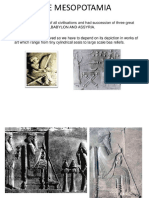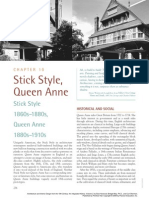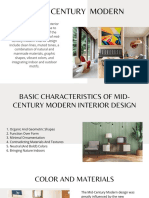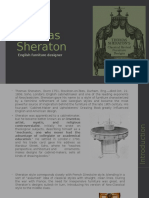Architecture and Interior Design - 19th Century - Ch03
Architecture and Interior Design - 19th Century - Ch03
Uploaded by
Bunduche IngaCopyright:
Available Formats
Architecture and Interior Design - 19th Century - Ch03
Architecture and Interior Design - 19th Century - Ch03
Uploaded by
Bunduche IngaOriginal Title
Copyright
Available Formats
Share this document
Did you find this document useful?
Is this content inappropriate?
Copyright:
Available Formats
Architecture and Interior Design - 19th Century - Ch03
Architecture and Interior Design - 19th Century - Ch03
Uploaded by
Bunduche IngaCopyright:
Available Formats
100938 C PH/OH/CHET A H d P N 54 C/M/Y/K
DESIGN SERVICES OF
54
Early-19th-century architecture in Germany and Austria
continues the Neoclassical development first in the
Greek Revival style, which is followed by a more eclec-
tic approach that encompasses the Italian Renaissance,
Byzantine, Early Christian, and Romanesque. The term
Biedermeier applies mainly to middle-class interiors and
furniture in Austria and Germany during the period
of 1815 to 1848. This style, an adaptation of French
Empire, replaces formality and majesty with comfort and
function.
HISTORICAL AND SOCIAL
The German states, including Austria and Prussia, wage
war against France for nearly 18 years before defeating
Napoleon in 1813. In 1814, the Congress of Vienna
convenes to decide the fate of Napoleons empire. To help
alleviate Germanys social, political, and economic prob-
lems, the Congress establishes the German Confederation
to replace the Holy Roman Empire and Napoleons Con-
federation of the Rhine. The German Confederation
unites 39 German states and Prussia under Austrian rule.
Each state retains its independence and government.
As Minister of Foreign Affairs, Prince Clemens von
Metternich of Austria strives to preserve the alliance by
suppressing liberalism and nationalism. He institutes
strong censorship and authoritarian rule, maintained by
surveillance and repression. At the same time, he brings
about economic recovery, which sustains his political
stranglehold. Eventually, the growth of the middle class
and the prosperity brought by the Industrial Revolution
bring change in the form of revolutions beginning in 1848.
With political activism prohibited, people turn inward,
focusing on their homes and families (Fig. 3-1). They pursue
C H A P T E R 3
German
Greek
Revival,
Biedermeier
1815-1848
The term Biedermeier, first used in 1853, was given
to a political caricature appearing in the Fleigende
Bltter who typified a well-to-do middle-class man
without culture. Biedermeier furniture, marked by its
commonplace forms, is a potpourri of early
nineteenth-century classicismSheraton, Regency,
Directoire, and especially French Empirewith
certain traits of its own.
Louise Ade Boger, Furniture Past and Present, 1966
M03_HARW5385_01_SE_C03.QXD 4/10/08 1:46 PM Page 54
2
0
0
9
9
3
3
3
9
0
Architecture and Interior Design from the 19th Century: An Integrated History, Volume 2, by Buie Harwood, Bridget May, Ph.D., and Curt Sherman.
Published by Prentice Hall. Copyright 2009 by Pearson Education, Inc.
GERMAN GREEK REVI VAL, BI EDERMEI ER 55
100938 C PH/OH/CHET A H d P N 55 C/M/Y/K
DESIGN SERVICES OF
tranquil, informal lifestyles in which visiting and entertaining
friends are commonplace activities. Family members engage
in hobbies and pastimes, such as reading, needlework, letter
writing, or making scrapbooks. Practicality and coziness are
more important than display and opulence are.
The period is a golden age for music and literature. Par-
ticularly admired are the musical accomplishments of
Franz Schubert, Ludwig van Beethoven, and Franz Joseph
Haydn. Opera houses and music halls are filled to capacity.
Those who can afford it own a clavichord and/or other type
of musical instrument. Germans also highly esteem litera-
ture, owning numerous books and/or borrowing from local
libraries. However, censorship and repression extend even
to favored musicians, writers, and their works. To avoid
government censors, authors and writers often attend the
newly fashionable literary salons held in individual homes.
CONCEPTS
As elsewhere in Europe, Neoclassicism is the style of
choice in the German states during the first decades of the
19th century. Architecture and furniture sometimes show
strong French influence because German designers study
in France, read French theorists, and emulate French de-
signs despite wars between the two countries and Napoleons
domination. Princes and aristocrats often hire French
designers for their palaces and other structures.
In the early years of the 19th century, most buildings are
Greek Revival style. German architects favor Greek archi-
tecture over Roman because of the honesty of structure
they believe it exhibits. They and their patrons also think
that the German spirit is embodied in Greek architecture;
thus, architecture fulfills a political and social role as in
France. During the 1830s, architects adopt a more eclectic
approach, choosing attributes and details from Italian
Renaissance, Romanesque, and Byzantine. Following other
countries, by midcentury German architecture displays a
multiplicity of styles.
German nobility prefers the formal and majestic Empire
for important interiors to express rank, status, majesty, and
grandeur. In contrast, the middle class adopts a simpler style
for their homes that becomes known as Biedermeier. Origi-
nally pejorative, the term is first applied to furniture in the
late 19th century. The expression combines bieder, meaning
plain or unpretentious, and meier, a common German last
name.
Biedermeier interior planning centers on function and
comfort instead of rank and display. Rooms accommodate
a variety of family activities within a warm, inviting atmo-
sphere. Similarly, furniture designs strive for use and prac-
ticality in contrast to the grandiose spirit of Empire.
Middle-class values, such as the importance of family, mod-
esty, and simplicity, are common themes in rooms and
furnishings.
DESIGN CHARACTERISTICS
As in other European countries, classicism in form, propor-
tion, and details dominate German architecture, high-style
interiors, and furniture. Architecture and interiors in middle-
class homes especially favor simplicity and function.
German Greek Revival. Greek Revival architecture in
Germany, like that of other countries, derives its details
primarily from ancient Greek and its forms mainly from
Roman architecture. The style features Greek and Roman
temple forms, the Greek orders, plain walls, and minimal,
classically derived ornament. It also reveals such classical
attributes as symmetry, repose, and a concern for propor-
tion. Geometric solidscubes, rectangles, or cylinders
compose buildings as well as furniture. Reproductions and
3-1. Costumes of a
man and woman.
IMPORTANT TREATISES
Gadanken ber die Nachahmung griechischer
Werke inder Malerei und Bildhauerkunst.
(Thoughts on the Imitation of Greek Works of Art
in Painting and Sculpture), 1759; Johann
Johachim Winckelmann.
Ideen zu Zimmerverzierungen. (Ideas for Room
Decorations), 17951800; Friedrich August Leo.
Sammlung Architektonischer Entwrfe.
(Collection of Architectural Drawings), 1819
1843; Karl Friedrich Schinkel.
Theory of Color. 1810; Johann Wolfgang
Goethe.
Vorbilder fr Fabrikanten und Handwerker
(Models from Manufacturers and Craftsmen),
1819; Karl Friedrich Schinkel.
M03_HARW5385_01_SE_C03.QXD 4/10/08 1:46 PM Page 55
2
0
0
9
9
3
3
3
9
0
Architecture and Interior Design from the 19th Century: An Integrated History, Volume 2, by Buie Harwood, Bridget May, Ph.D., and Curt Sherman.
Published by Prentice Hall. Copyright 2009 by Pearson Education, Inc.
56 LATE NEOCLASSI CAL
100938 C PH/OH/CHET A H d P N 56 C/M/Y/K
DESIGN SERVICES OF
adaptations of Grecian and Roman prototypes, such as the
Parthenon and Pantheon, frequently characterize monu-
ments and important buildings. As time progresses, more
ornament and a broader spectrum of prototypes overcome
the plainer Grecian style.
Biedermeier. Biedermeier interiors display bright colors,
good lighting, warm woods, plants, and flowers, contribut-
ing to an inviting atmosphere. Rooms and furnishings are
small in scale. Drawing rooms often have a lot of furniture,
especially chairs, to support numerous activities. Families
personalize their homes with portraits, silhouettes, pic-
tures, and collections. Biedermeier furniture, a pared-down
version of French Empire, features light woods, minimal
embellishment, and geometric forms. Designed by crafts-
men, examples reveal the concern of the artisan for en-
hancing the materials. As in France, some pieces derive
from classical prototypes. Biedermeier also reveals influ-
ences from Sheraton and Regency of England.
Motifs. Architecture and furniture exhibit classical
motifs (Fig. 3-2, 3-12, 3-13, 3-18) including columns,
Egyptian terms, pediments, Greek key or fret, acanthus
leaves, palmettes, lyres, urns, hearts, arrows, and a stylized
Prince of Wales motif.
ARCHITECTURE
Neoclassicism, which begins in the second half of the 18th
century in Germany, continues to define architecture dur-
ing the first decades of the 19th century. German archi-
tects are not stylistic innovators, neither are they mere
copyists of the work of others. Their genius lies in the abil-
ity to synthesize ancient Greek and Roman, French, and
English influences and their own past styles into a unique
German vision. French inspiration is evident in rational-
ism, geometric forms, Gothic-type structures, and vision-
ary architecture. An underlying Romanticism stems from
England, particularly in gardens and settings.
Buildings exhibit the hallmarks of Neoclassicism: clean
lines, plain walls, smooth or slightly rusticated surfaces,
geometric forms, and entire structures or just the details
derived from antique prototypes. The geometric forms that
make up buildings retain their individuality instead of
blending into a whole. Some structures copy ancient edi-
fices, while others exhibit an antique flavor. Greek Revival
is favored for the first two decades of the 19th century.
After that, an increase in ornament and number of styles
signals a move away from the single classical vision toward
a broader, more eclectic approach that is inspired by the
Italian Renaissance, Romanesque, or Byzantine.
3-2. Architectural and interior details.
3-3. Brandenburg Gate, 17891793; Berlin, Germany; by
C. G. Langhans.
IMPORTANT BUILDINGS AND INTERIORS
Berlin, Germany:
Altes Museum, 18231830; Karl Friedrich
Schinkel.
Bauakademie, 18311836; Karl Friedrich Schinkel.
Brandenburg Gate, 17891793; C. G. Langhans.
Hauptwache, 1840s; Karl Friedrich Schinkel.
Neue Wache (New Guard House), 18161818;
Karl Friedrich Schinkel.
Schauspielhaus (Royal Theater; now called
Konzerthaus), 1821; Karl Friedrich Schinkel.
Munich, Germany:
The Glyptothek (sculpture gallery), 18161830;
Leo von Klenze.
Propylaea, 18461860; Leo von Klenze.
Ruhmes-Halle, early 19th century, Leo von
Klenze.
Potsdam, Germany:
Schloss Charlottenhof, 18261827; Karl
Friedrich Schinkel.
Regensburg area, Germany:
The Walhalla, 18301842; Leo von Klenze.
M03_HARW5385_01_SE_C03.QXD 4/10/08 1:46 PM Page 56
2
0
0
9
9
3
3
3
9
0
Architecture and Interior Design from the 19th Century: An Integrated History, Volume 2, by Buie Harwood, Bridget May, Ph.D., and Curt Sherman.
Published by Prentice Hall. Copyright 2009 by Pearson Education, Inc.
DESIGN SPOTLIGHT
GERMAN GREEK REVI VAL, BI EDERMEI ER 57
100938 C PH/OH/CHET A H d P N 5 C/M/Y/K
DESIGN SERVICES OF
In Germany, architects develop the first of the Greek
Revival ceremonial gateways, the Brandenburg Gate in
Berlin (17891793; Fig. 3-3), and the first museum
designed for sculpture, Glyptothek, Munich (18161830).
Of the numerous excellent architects, Karl Friedrich
Schinkel and Leo von Klenze are the most outstanding.
Schinkel in Berlin and von Klenze in Munich design a va-
riety of building types in the Neoclassical style, transform-
ing those cities and affecting architectural design of their
day and with continued influence, even to the Modern
Movements in the early 20th century.
Public and Private Buildings
Types. Building types include museums (Fig. 3-5), monu-
ments, gateways, galleries, theaters (Fig. 3-4), prisons, facto-
ries, markets, squares, row houses, apartments, and palaces.
Classical motifs
Layered facade
Temple front
Plain walls
Rectangular windows
Pediment
Podium
Center axis
3-4. Schauspielhaus; Berlin, Germany.
3-5. Altes Museum, 18231830; Berlin, Germany; Karl
Friedrich Schinkel.
Architecture: Schauspielhaus (Royal Theater, now called
Konzerthaus), 1821; Berlin, Germany; Karl Friedrich
Schinkel. An important early building by Schinkel, he re-
ceives a commission from the king to design a new theater
to replace an earlier one that burned. The king requires
that Schinkel follow the footprint of the previous theater
and reuse some elements, such as the Ionic columns.
Schinkel devises a three-part structure with a prominent
main center faade approached by processional front steps
and crowned by a temple front using the Ionic columns. He
further articulates the image of Neoclassicism with classic
ordering, rustication, straight lines, rectangular windows,
and plain walls. The front vertical planes are layered to
achieve depth and movement. Additional classical motifs
highlight the prominent points of the roof and reiterate
the classical language. Because of its frequent use and
its location in an important Berlin square, the building
becomes a symbolic statement of German Greek Revival
architecture. A Greek amphitheater plan inspires the form
of the auditorium.
M03_HARW5385_01_SE_C03.QXD 4/10/08 1:46 PM Page 57
2
0
0
9
9
3
3
3
9
0
Architecture and Interior Design from the 19th Century: An Integrated History, Volume 2, by Buie Harwood, Bridget May, Ph.D., and Curt Sherman.
Published by Prentice Hall. Copyright 2009 by Pearson Education, Inc.
58 LATE NEOCLASSI CAL
100938 C PH/OH/CHET A H d P N 58 C/M/Y/K
DESIGN SERVICES OF
3-9. Propylaea, 18461860; Munich, Germany; Leo von
Klenze.
3-7. Hauptwache, 1840s; Berlin, Germany; Karl Friedrich
Schinkel.
3-8. Ruhmes-Halle, early 19th century; Munich, Germany;
Leo von Klenze.
3-10. Palace of Count Portales, early 19th century; Berlin,
Germany.
3-11. Faade detail,
Wohnhaus, early 19th century;
Berlin, Germany.
Site Orientation. Monuments and important buildings sit
in open spaces to enhance their importance (Fig. 3-3, 3-4,
3-5, 3-8). Further emphasizing them are ceremonial en-
trances composed of staircases and gateways modeled on
those of the Acropolis in Athens. Museums, even though
3-6. Bauakademie, 18311836; Berlin, Germany; Karl
Friedrich Schinkel.
M03_HARW5385_01_SE_C03.QXD 4/10/08 1:46 PM Page 58
2
0
0
9
9
3
3
3
9
0
Architecture and Interior Design from the 19th Century: An Integrated History, Volume 2, by Buie Harwood, Bridget May, Ph.D., and Curt Sherman.
Published by Prentice Hall. Copyright 2009 by Pearson Education, Inc.
located in more crowded urban settings, maintain ceremo-
nial entrances. Other structures locate along streets or in
squares that are carefully planned. Palaces are situated in
picturesque gardens.
Floor Plans. Most plans are symmetrical and composed
of rectangular, square, and/or round or apsidal spaces. For
palaces and monuments, progression, ceremony, and status
are important concepts in space planning. Museums re-
quire spaces in a variety of shapes and sizes to display their
collections more effectively.
Materials. Northern Germany favors brick, while other
areas use local building stone. Schinkel introduces colored
brick, terra-cotta, and cast iron.
Facades. Podia with front or angled staircases, porticoes,
temple fronts, or colonnades announce important build-
ings (Fig. 3-4, 3-5, 3-7, 3-8). Greek prototypes, such as the
Parthenon or the stoa, inspire the designs of these porti-
coes and colonnades. Greek Doric is the most common or-
der followed by Corinthian. Alternatively, some facades
have round arches instead of columns. Pilasters or engaged
columns create bays on lesser buildings or the side walls of
important ones (Fig. 3-6). Stringcourses may separate sto-
ries, and friezes or cornices accentuate the junction of wall
and roof (Fig. 3-10). In keeping with Neoclassical design,
walls tend to be blank and smoothly finished or lightly
rusticated (Fig. 3-7, 3-9, 3-10, 3-11).
Windows. Columns, pilasters, or plain lintels may
accentuate rectangular windows and form a rectangular
grid across the faade. Arched or round windows are
uncommon until the third decade of the 19th century
when Renaissance prototypes, particularly those by An-
drea Palladio and Guilio Romano, become design
sources.
Doors. Porticoes, temple fronts, or aedicula define and
emphasize entrances (Fig. 3-4, 3-7, 3-9).
Roofs. Low-pitched gabled roofs in keeping with Greek
architecture are typical. Some structures, such as museums
and churches, may have domes.
Later Interpretations. As in other countries, Germany
participates in the Classical Revival at the end of the 19th
century. The simplicity and geometry of Neoclassical
design affect early modern architects.
INTERIORS
Following the lead of the French, German and Austrian
nobility choose the Empire style especially for ceremonial
spaces in their homes, palaces, theaters, and museums
(Fig. 3-12, 3-13). Middle class members, however, find it
too opulent and expensive. They do not share the Empire
vision of grandeur. Instead, they want rooms that focus on
comfort and simplicity. They find these ideals in the
Biedermeier style.
In middle-class homes, human-scale rooms have a
warm, comfortable, and inviting feeling created and en-
hanced by good lighting, bright colors, and modest fur-
nishings. Collections of glassware, needlework, or other
prized possessions, and family silhouettes or portraits attest
to the importance of the family and personalize the spaces.
Floral patterns, plants, flowers, birds, and fish bring in the
natural world. Numerous watercolors and paintings of do-
mestic interiors from the period indicate the significance
of domestic spaces.
Private Buildings
Types. Most middle-class apartments are small. Typical
spaces are the drawing room, dining room, bedrooms, one
or two dressing rooms, and a study or library, service areas,
and servants quarters.
Relationships. Attention focuses on the drawing room
as the center of family life (Fig. 3-14, 3-15, 3-16). Space
planning requires zones for activities such as reading,
hobbies, or letter writing. Furniture lines the walls and
fills corners, leaving the center of the space open, but
pieces can be moved where needed. Bedrooms are
sparsely furnished with a bed, bedside table, chair, couch,
and wardrobe.
GERMAN GREEK REVI VAL, BI EDERMEI ER 59
100938 C PH/OH/CHET A H d P N 59 C/M/Y/K
DESIGN SERVICES OF
DESIGN PRACTITIONERS
Josef Ulrich Danhauser (17801829) is the best-
known Biedermeier cabinetmaker in Vienna. He
designs all types of furniture, accessories, upholstery,
and window treatments. Beginning in 1804, his
factory, Danhausersche Mbelfabric, supplies
furnishings to both the nobility and middle class.
Leo von Klenze (17841864), an architect and
furniture designer, works mostly in Munich. After
studying with Percier and Fontaine in Paris, he
develops a passion for antiquity that is reflected
in his work. Like others, he designs many different
building types and works mostly in the Greek
Revival and Neoclassical styles. Klenze and his
great patron, the Crown Prince of Bavaria, strive
to transform Munich into a modern capital.
Karl Friedrich Schinkel (17811841) is the
foremost and most prolific German architect of
the period. Schinkel designs many different
building types in a variety of styles from Greek
Revival to a more eclectic classicism to Gothic. His
later work reveals concern for picturesque
environments, informality, and asymmetry, and he
introduces cast iron for structures, details, and
furniture. Later designers admire the unity,
functionality, and what they perceive as the
German character of his work.
M03_HARW5385_01_SE_C03.QXD 4/10/08 1:46 PM Page 59
2
0
0
9
9
3
3
3
9
0
Architecture and Interior Design from the 19th Century: An Integrated History, Volume 2, by Buie Harwood, Bridget May, Ph.D., and Curt Sherman.
Published by Prentice Hall. Copyright 2009 by Pearson Education, Inc.
Color. Colors are light and bright. The typical palette
contains green, blue, yellow, gray, or brown.
Lighting. Most rooms have good natural lighting from
large windows. Artificial lighting comes from ceiling
fixtures, such as lanterns or small chandeliers, sconces,
and candlesticks (Fig. 3-14, 3-15). A few people can afford
oil lamps.
Floors.Floors are wood planks or, occasionally, parquet.
Wall-to-wall machine-made carpet or area rugs in brightly
colored geometric or floral patterns are common floor cov-
erings. Oriental rugs are not affordable for most people.
Walls. Typical treatments are paint or wallpaper (Fig.
3-14, 3-15, 3-16). Painted walls usually are a solid, light
color. The use of wallpaper increases during the period
because industrialization reduces the cost and increases
availability. Patterns include stripes, geometrics, florals, or
60 LATE NEOCLASSI CAL
100938 C PH/OH/CHET A H d P N 60 C/M/Y/K
DESIGN SERVICES OF
3-12. Interior, Schauspielhaus (Royal Theater), 1821; Berlin;
Karl Friedrich Schinkel.
3-13. Rotunda, Altes Museum, 18231830; Berlin; Karl
Friedrich Schinkel.
3-14. Drawing room, c. 18201830; Germany.
imitations of textiles. Both papered and painted walls may
have borders in complementary colors and patterns.
Baseboards, cornice moldings, and trim around doors and
windows usually contrast with the wall color.
Window Treatments. Window treatments vary from simple
white muslin swags with fringe to multiple swags in brightly
M03_HARW5385_01_SE_C03.QXD 4/10/08 1:46 PM Page 60
2
0
0
9
9
3
3
3
9
0
Architecture and Interior Design from the 19th Century: An Integrated History, Volume 2, by Buie Harwood, Bridget May, Ph.D., and Curt Sherman.
Published by Prentice Hall. Copyright 2009 by Pearson Education, Inc.
Ceilings. Ceilings are usually plain gray or white. Some
have painted decorations, wallpaper borders, plasterwork,
or plaster rosettes (Fig. 3-14, 3-15).
Later Interpretations. The simple, sparsely furnished Bie-
dermeier interior appeals to designers of the late 19th and
20th centuries (Fig. 3-17).
FURNISHINGS AND DECORATIVE ARTS
Like the interiors, Biedermeier furniture is human scaled,
comfortable, and simple in design. Designers are influenced
by French Empire, English Regency, Sheraton, Louis XVI,
and Rococo. Mostly made by artisans, it reflects a high
degree of craftsmanship and concern for the material. Func-
tion supercedes display as a design goal. Like architecture,
furniture is composed of geometric solids and may display
classical attributes or copy or adapt antique prototypes.
Early examples (18151830) are rectangular in form
with minimal decoration. Beauty and interest lie in the
grain of the wood and the geometric or curvilinear
composition. Classical restraint defines the image. Never-
theless, some furniture displays eccentricity with odd
shapes and unusual decoration. Later furniture (1830
1848) moves away from classical restraint to greater exag-
geration with more ornament, curves, and bulges.
Innovation and fashion replace function and simplicity as
industrialization takes hold. Machines make more and
more furniture, providing consumers with many types of
furniture in numerous styles.
Public and Private Buildings
Types. New furniture pieces include plant stands, tables
for birdcages, magazine racks, and vitrines to display treas-
ured objects.
GERMAN GREEK REVI VAL, BI EDERMEI ER 61
100938 C PH/OH/CHET A H d P N 61 C/M/Y/K
DESIGN SERVICES OF
3-15. Drawing room, Greymuller Schlossl House, c. 1820s
1830s; Germany.
3-16. Drawing room, c. 1820s1840s; Germany.
3-17. Later Interpretation: Living room; published in The
Room Beautiful, 1916. Biedermeier interpretation.
colored fabrics trimmed with braid, fringe, and tassels. Floor-
length curtains and glass curtains may hang beneath the
swags. Sometimes unpatterned window treatments offer the
only respite from pattern in the Biedermeier room.
Doors. Doors are plain, paneled, dark wood with simple,
painted surrounds.
M03_HARW5385_01_SE_C03.QXD 4/10/08 1:46 PM Page 61
2
0
0
9
9
3
3
3
9
0
Architecture and Interior Design from the 19th Century: An Integrated History, Volume 2, by Buie Harwood, Bridget May, Ph.D., and Curt Sherman.
Published by Prentice Hall. Copyright 2009 by Pearson Education, Inc.
62 LATE NEOCLASSI CAL
100938 C PH/OH/CHET A H d P N 62 C/M/Y/K
DESIGN SERVICES OF
3-19. Armchair, c. 1825;
Austria.
DESIGN SPOTLIGHT
3-18. Designs for 15 side chairs.
Furniture: Designs for Fifteen Side Chairs, c. 1805;
Germany and other chairs from Austria. These side chairs
illustrate the variety, simplicity, and elegance of Bie-
dermeier furniture, with rectangular forms minimal dec-
oration, and Classical restraint. Curved open backs are
inspired by French Empire and English Regency exam-
ples. Front legs are straight and tapered, while the rear
legs are a delicate saber style. Beauty and interest lie in
the grain of the wood and the geometric or curvilinear
composition. Fruitwood and mahogany are the most
used woods. Seats are upholstered in textiles fashionable
at the time, with patterns having classical motifs.
Distinctive Features. Large areas of veneer that
emphasize the grain of the wood characterize most
Biedermeier furniture (Fig. 3-18, 3-20, 3-21, 3-22).
Pieces are composed of geometric solids that do not
blend or unify, but assert themselves as in architecture.
Although the furniture is volumetric, it maintains a pla-
nar appearance. Like French Empire furniture, Bieder-
meier has an angular silhouette with sharp corners,
smooth surfaces, and frontal appearance. Unlike Empire,
there is little gilding, few bronze mounts, and no feeling
of pompousness or majesty.
Relationships. Furniture is light in scale and often multi-
purpose to suit small spaces.
Curved open back in fruitwood
with no decoration
Legs in back are saber style
Legs in front are tapered
Upholstery with stripes and
classical motifs
M03_HARW5385_01_SE_C03.QXD 4/10/08 1:46 PM Page 62
2
0
0
9
9
3
3
3
9
0
Architecture and Interior Design from the 19th Century: An Integrated History, Volume 2, by Buie Harwood, Bridget May, Ph.D., and Curt Sherman.
Published by Prentice Hall. Copyright 2009 by Pearson Education, Inc.
glass plaques; or painted, stenciled, or transfer-printed dec-
orations. Inlay and stringing in ebony or other dark woods
outline or accentuate legs, backs, drawers, and doors.
Seating. Unlike Empire, Biedermeier seating looks com-
fortable and inviting with its curves and deep, overstuffed
seats. Seating comes in many forms with numerous details.
Side chairs (Fig. 3-18) outnumber armchairs (Fig. 3-19)
because they are more easily moved. Legs may be turned,
sabers, or straight and tapered with or without a slight
GERMAN GREEK REVI VAL, BI EDERMEI ER 63
100938 C PH/OH/CHET A H d P N 63 C/M/Y/K
DESIGN SERVICES OF
3-21. Secrtaire, from
Castle Zeil, 1830; Germany.
3-23. Later Interpretation: Bureau, c. 1850s1860s; Texas.
3-22. Pearwood furniture, bedroom for Queen Louise,
Charlottenburg Castle; Germany; Karl Friedrich Schinkel.
3-24. Later Interpretation:
Side chair of molded lucite,
1939; United States; Elsie de
Wolfe.
3-20. Sofas, c. 18201840s; Germany and New York.
Materials. Cabinetmakers use local woods, predomi-
nately light-colored fruitwoods, maple, birch, ash, or cherry.
Imported or exotic woods are too expensive for most
people. Some pieces have inlay; marquetry; porcelain or
M03_HARW5385_01_SE_C03.QXD 4/10/08 1:47 PM Page 63
2
0
0
9
9
3
3
3
9
0
Architecture and Interior Design from the 19th Century: An Integrated History, Volume 2, by Buie Harwood, Bridget May, Ph.D., and Curt Sherman.
Published by Prentice Hall. Copyright 2009 by Pearson Education, Inc.
rectangular, but some, particularly later, exhibit great
creativity in form and shape. Inside the drop front are
numerous drawers, secret drawers, and pigeonholes. Tops
may have pediments or rectangular boxes diminishing in
size. Corners may have columns in contrasting colors.
Some secretaries have matching wardrobes. Doors of sec-
retaries and wardrobes may have veneer patterns such as
sunbursts. Other wardrobes have two doors, sometimes
mirrored, with columns on the corners. Chests with three
or four drawers also store possessions in drawing rooms and
bedrooms. Vitrines or display cabinets show off prized
possessions of the family. They have glass on three sides
and a mirrored back. tagres hold books and/or display
collections.
Beds. Like other furniture, beds display great variety in
design (Fig. 3-22). Poster or French beds with equal-height
head- and footboards are common, but four-posters are
most favored. Beds are usually draped. They may have
matching night tables.
Upholstery. Local textiles dominate Biedermeier fur-
nishings because imported ones are too expensive. Com-
mon upholstery textiles include horsehair, needlework,
velvet, printed cotton, linen, or wool. Only the nobility
can afford silk. Abstract patterns in strong colors are
favored. Sometimes chairs and sofas have lengths of fabrics
draped over them or furniture covers in garish colors with
contrasting edge bands.
Decorative Arts. Mirrors, numerous pictures, family por-
traits, or silhouettes hang on walls. Screens may divide
spaces or hide beds in drawing rooms and washstands in
bedrooms. Proudly displayed, porcelain has classical or urn
shapes with naturalistic plants and flowers in colored pan-
els or surrounded by borders. Blown and cut glass, plain or
colored, is particularly prized. Bavaria is an important and
well-known center for glassmaking.
Later Interpretations. Vernacular interpretations of Bieder-
meier occur throughout the United States in the mid to late
19th century particularly where Germans settle and crafts
productionflourishes, suchas inTexas (Fig. 3-23). The light-
colored woods; simple, planar forms; functionality; minimal
ornament; and unpretentiousness of Biedermeier influence
subsequent modern movements, including Art Nouveau
(called Jugendstil in Germany) and Art Deco. Designers who
adapt the basic forms of Biedermeier include Josef Hoffman,
Peter Behrens, and Elsie de Wolfe (Fig. 3-24). Because of its
basic simplicity, todays manufacturers market furniture
based upon Biedermeier (Fig. 3-25).
64 LATE NEOCLASSI CAL
100938 C PH/OH/CHET A H d P N 64 C/M/Y/K
DESIGN SERVICES OF
3-25. Later Interpretation: DG dining chair, walnut and
blackened steel, 2003; United States; Gulassa & Co., Inc.
outward curve near the floor. Rear legs are sabers. Trape-
zoid or round seats are upholstered, whereas backs usually
are not. Backs exhibit the greatest variety of design from
ladderbacks to interpretations of the Greek klismos, shield
shapes, fan shapes, splats, trellises, lyres, balloons, rectan-
gles, and other geometric shapes (Fig. 3-18). Sofas (Fig. 3-20)
often correspond in design to chairs. Corner banquettes are
a Biedermeier innovation. Later seating may be highly
imaginative interpretations of classicism or even breaks
with it.
Tables. Biedermeier drawing rooms or libraries are filled
with many tables for work, games, writing, and display
(Fig. 3-14, 3-16). Also common are sofa tables and pier or
console tables. Tables display infinite variety in shape, form,
and leg styles. Geometric solids, like architecture, or curvi-
linear shapes define the form and silhouette. Round and rec-
tangular tops have inlay, stringing, or veneer patterns such as
stars or sunbursts. Tables may have a single center support or
three or four scroll-shaped, turned, straight, or tapered legs.
Storage. Storage pieces are important in drawing rooms
and bedrooms. Nearly every drawing room has a secretary
or drop-front desk (Fig. 3-21). Most desks are tall and
M03_HARW5385_01_SE_C03.QXD 4/10/08 1:47 PM Page 64
2
0
0
9
9
3
3
3
9
0
Architecture and Interior Design from the 19th Century: An Integrated History, Volume 2, by Buie Harwood, Bridget May, Ph.D., and Curt Sherman.
Published by Prentice Hall. Copyright 2009 by Pearson Education, Inc.
You might also like
- Viaje A MadridDocument294 pagesViaje A Madridbigliang98No ratings yet
- The Encyclopedia of Furniture (Art History Ebook) PDFDocument500 pagesThe Encyclopedia of Furniture (Art History Ebook) PDFGODEANU FLORIN94% (35)
- Architecture and Interior Design - 19th Century - Ch01Document30 pagesArchitecture and Interior Design - 19th Century - Ch01Bunduche IngaNo ratings yet
- Mid-Century ModernDocument30 pagesMid-Century Modernjamesmorrissey3100% (14)
- 50 Chairs That Changed The WorldDocument57 pages50 Chairs That Changed The Worldcap97% (32)
- Furniture - Judith Miller PDFDocument561 pagesFurniture - Judith Miller PDFEmmanuel Castañeda Pérez100% (12)
- The Master Chair Maker's ArtDocument77 pagesThe Master Chair Maker's Artfvict874100% (2)
- Architectural HistoryDocument72 pagesArchitectural HistoryKaye Ann GonzalesNo ratings yet
- A History of FurnitureDocument502 pagesA History of FurnitureOdam Furniture100% (10)
- Mid-Century Modern Furniture Evolution: 8 Designers Who Changed The Industry Part 1Document13 pagesMid-Century Modern Furniture Evolution: 8 Designers Who Changed The Industry Part 1GereonB67% (3)
- Art Deco PDFDocument0 pagesArt Deco PDFAlban Baros100% (3)
- ID CITY Identities Italian CitiesDocument219 pagesID CITY Identities Italian Citiescontemporary1977No ratings yet
- Hindustan Hydraulics PVT LTD: Dear SirDocument9 pagesHindustan Hydraulics PVT LTD: Dear SirSitaram TilekarNo ratings yet
- Architecture and Interior Design - 19th Century - Ch04Document26 pagesArchitecture and Interior Design - 19th Century - Ch04Bunduche Inga100% (3)
- Architecture and Interior Design - 19th Century - Ch07Document27 pagesArchitecture and Interior Design - 19th Century - Ch07Bunduche Inga100% (1)
- Architecture and Interior Design - 19th Century - Ch02Document22 pagesArchitecture and Interior Design - 19th Century - Ch02Bunduche IngaNo ratings yet
- 1 History of FurnitureDocument13 pages1 History of FurnitureRitakshi Taneja100% (1)
- Architecture and Interior Design - 19th Century - Ch05Document27 pagesArchitecture and Interior Design - 19th Century - Ch05Bunduche Inga100% (1)
- Architecture and Interior Design - 19th Century - ch10Document30 pagesArchitecture and Interior Design - 19th Century - ch10Bunduche Inga100% (1)
- A History of Interior Design PDFDocument408 pagesA History of Interior Design PDFJuan Pedro Sebastiá Rico100% (1)
- 20th Century Furniture & Decorative Arts - Skinner Auction 2531BDocument172 pages20th Century Furniture & Decorative Arts - Skinner Auction 2531BSkinnerAuctions100% (1)
- Interior DesignDocument2 pagesInterior DesignLem PaneloNo ratings yet
- History of Interior Design: Ancient EgyptDocument86 pagesHistory of Interior Design: Ancient Egyptzgubyutza9593No ratings yet
- History of Furniture: Vishwakirti Baghel Priyanka Bodhak Avni BahetyDocument77 pagesHistory of Furniture: Vishwakirti Baghel Priyanka Bodhak Avni BahetyA Designertect100% (4)
- 100 Chairs EBladDocument8 pages100 Chairs EBladSulis Gingsul ASNo ratings yet
- Furniture Styles: By: Myeisha FoleyDocument12 pagesFurniture Styles: By: Myeisha FoleyAdina BadeaNo ratings yet
- Furniture Design HistoryDocument8 pagesFurniture Design HistoryTudor Marincas100% (1)
- 2 Art Nouveau (1890-1910)Document47 pages2 Art Nouveau (1890-1910)gozumkyla0122No ratings yet
- ArchitectureDocument224 pagesArchitecturefrancescleo8duran100% (1)
- History of Furniture: Pre World War To Modernism (1900-1945)Document22 pagesHistory of Furniture: Pre World War To Modernism (1900-1945)Aayushi GoyalNo ratings yet
- Architectural Style GuideDocument18 pagesArchitectural Style GuideHariomMaheshwari100% (2)
- Mid Century ModernDocument6 pagesMid Century ModernKIRANo ratings yet
- Top 100 Furniture Trends 2014Document34 pagesTop 100 Furniture Trends 2014Liana LimjocoNo ratings yet
- Chapter 3.4 - Art DecoDocument56 pagesChapter 3.4 - Art Decocricket review100% (1)
- History of Furnitures DesignDocument155 pagesHistory of Furnitures Designmano100% (2)
- NY050219 CatalogDocument282 pagesNY050219 CatalogMarco RezzonicoNo ratings yet
- History of Arts and Interior Design - Mock Exam 2015 Flashcards - QuizletDocument11 pagesHistory of Arts and Interior Design - Mock Exam 2015 Flashcards - QuizletCh-47JDZNo ratings yet
- FurnitureDocument36 pagesFurniturelaura100% (1)
- The English Home - August 2022Document132 pagesThe English Home - August 2022Carolina Sosa100% (1)
- Interior Design in French Classic StyleDocument180 pagesInterior Design in French Classic Stylevalysa100% (2)
- Report About Late Georgian PeriodDocument16 pagesReport About Late Georgian PeriodCarlo MarasiganNo ratings yet
- 21 Architectural Styles PDFDocument23 pages21 Architectural Styles PDFNguyen Nhat My 20510801706100% (1)
- Furniture StylesDocument36 pagesFurniture Styleskumara nathanNo ratings yet
- Style Type of FurnitureDocument16 pagesStyle Type of FurnitureBelal Ahmed67% (3)
- Thomas SheratonDocument7 pagesThomas SheratonSanyam GargNo ratings yet
- Presentation: Art Deco + Small ArtsDocument108 pagesPresentation: Art Deco + Small ArtsRudra SahaiNo ratings yet
- Carl Hansen & Son 2016Document83 pagesCarl Hansen & Son 2016David Epson MayerNo ratings yet
- Environment Furniture Product BrochureDocument9 pagesEnvironment Furniture Product BrochureEnvironment FurnitureNo ratings yet
- Handbook of Furniture StylesDocument182 pagesHandbook of Furniture Stylesproteor_srl100% (8)
- Art Nouveau 6th SemDocument74 pagesArt Nouveau 6th SemEva LyngdohNo ratings yet
- Victorian Architecture PDFDocument292 pagesVictorian Architecture PDFJm tm100% (5)
- CHAIR PORTFOLIO Masood Khan PDFDocument10 pagesCHAIR PORTFOLIO Masood Khan PDFmasood khanNo ratings yet
- Modernist ArchitectureDocument64 pagesModernist ArchitectureChicken NoodlesNo ratings yet
- Modern FurnitureDocument104 pagesModern FurnitureCarmela Tan80% (5)
- Contemporary ArchitectureDocument113 pagesContemporary ArchitectureReeve Roger RoldanNo ratings yet
- Mid Century Living Room TrendsDocument51 pagesMid Century Living Room TrendsAna Jorgacevic100% (1)
- 09 Mendini ENGDocument128 pages09 Mendini ENGHarsha VardhanNo ratings yet
- Nicole Stanford PortfolioDocument23 pagesNicole Stanford PortfolioNicole StanfordNo ratings yet
- The Works in Architecture of Robert and James AdamFrom EverandThe Works in Architecture of Robert and James AdamRating: 4 out of 5 stars4/5 (2)
- Architecture of Middle Tennessee: The Historic American Buildings SurveyFrom EverandArchitecture of Middle Tennessee: The Historic American Buildings SurveyRating: 3.5 out of 5 stars3.5/5 (1)
- Romanesque Art and Architecture: EtymologyDocument5 pagesRomanesque Art and Architecture: EtymologyGillian Faye LechocoNo ratings yet
- Neoclassical ArchitectureDocument14 pagesNeoclassical ArchitecturelidetechristoszinabuNo ratings yet
- Rococo TGDocument17 pagesRococo TGSnowNo ratings yet
- Bagong Barrio Senior High School: Contact Information Other InformationDocument1 pageBagong Barrio Senior High School: Contact Information Other InformationPisonet UserNo ratings yet
- Bataan ProvinceDocument5 pagesBataan Provincekaye choiNo ratings yet
- Brochure With PolicyDocument2 pagesBrochure With Policysanthoshreddyb986No ratings yet
- Usa 08 1Document102 pagesUsa 08 1Kate RollinsNo ratings yet
- Fuentes v. CADocument4 pagesFuentes v. CAKonrad IbabaoNo ratings yet
- Bangladesh BSCDocument8 pagesBangladesh BSCAhmad BilalNo ratings yet
- Annual Income Tax ReturnDocument6 pagesAnnual Income Tax ReturnJojo ReyesNo ratings yet
- Pi (E) Day Payday!: Marketing Lead: Sam DomingoDocument4 pagesPi (E) Day Payday!: Marketing Lead: Sam DomingoYuan TugnaoNo ratings yet
- Summer Internship Programme 2018-19: National Aluminum Company Limited NalcoDocument59 pagesSummer Internship Programme 2018-19: National Aluminum Company Limited Nalcoanon_849519161No ratings yet
- BCPC Resolution Reommending PlanDocument3 pagesBCPC Resolution Reommending Planjomar78% (9)
- 0214 CQ Waz Award AppDocument2 pages0214 CQ Waz Award AppMartinus JapNo ratings yet
- DR Arlene's Leadership StoryDocument5 pagesDR Arlene's Leadership StoryGil OrenseNo ratings yet
- Hunt and Fish Club Dinner MenuDocument6 pagesHunt and Fish Club Dinner MenuNell CaseyNo ratings yet
- Surviving The Shift: Strategies of The Internet Cafés in The Face of Evolving Connectivity OptionsDocument10 pagesSurviving The Shift: Strategies of The Internet Cafés in The Face of Evolving Connectivity OptionsJohn Rey MedeloNo ratings yet
- NCERT Solutions For Class 12 Mar 30 English Core Book Flamingo Chapter 4 The RattrapDocument2 pagesNCERT Solutions For Class 12 Mar 30 English Core Book Flamingo Chapter 4 The Rattrapyash saravgiNo ratings yet
- Essence and FreedomDocument1 pageEssence and FreedomRuth Leah CasanaNo ratings yet
- Literary Piece in England: "Beowulf" by Laurence NowellDocument11 pagesLiterary Piece in England: "Beowulf" by Laurence NowellJoanne Manglal-lan100% (1)
- The RattrapDocument8 pagesThe RattrapMB. GamingsNo ratings yet
- PromotionalDocument1 pagePromotionalapi-248177428No ratings yet
- Jane - eyre.2006.EP1.XviD - Ac3 WAF EngDocument33 pagesJane - eyre.2006.EP1.XviD - Ac3 WAF EngAma DavidescuNo ratings yet
- PMT ResumeDocument2 pagesPMT Resumepmargosian0% (1)
- Self-Liquidating Inventory Loan: Rose - Chapter 17 #1Document37 pagesSelf-Liquidating Inventory Loan: Rose - Chapter 17 #1Lê Chấn PhongNo ratings yet
- Egomon Game RleDocument5 pagesEgomon Game RleInter InterNo ratings yet
- Cannon 11-27-2014Document76 pagesCannon 11-27-2014Dave MundyNo ratings yet
- Cyber Crime Research PaperDocument14 pagesCyber Crime Research PaperAshish singhNo ratings yet
- Nidan Volume 24 December 2012Document144 pagesNidan Volume 24 December 2012Nirmala1987No ratings yet
- Đáp án môn tiếng anhDocument3 pagesĐáp án môn tiếng anhSon Nguyen TranNo ratings yet

























































































